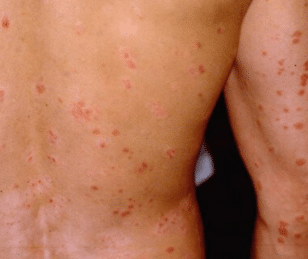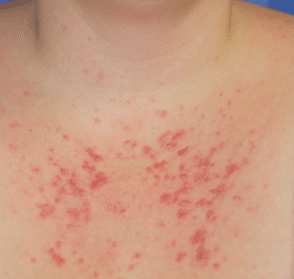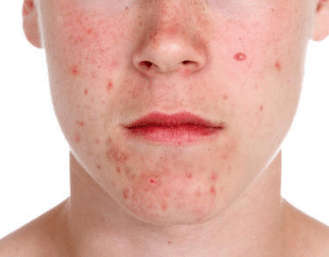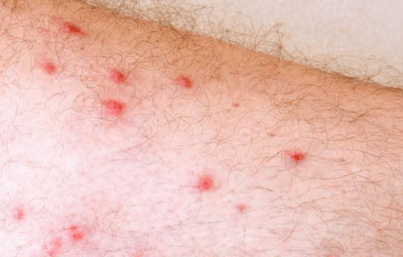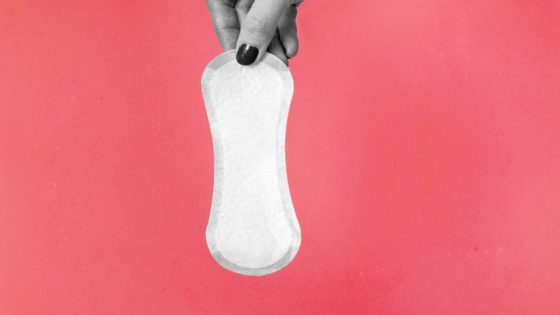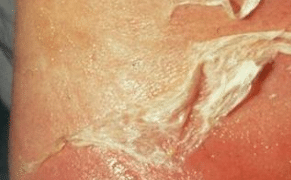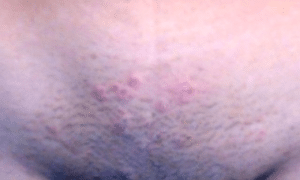Red Spots
Red Dots on Skin Causes, Itchy, Pinpointed, Small, Bright, on Legs, Face, Spots, How to Get Rid
on
What causes small red dots on skin? Explore on the causes of pinpointed dots on legs, face, all over body, how to get rid of them treatments and best home remedy.
Red Dots on Skin Causes
Red dots on the skin are also in medical terms referred to as blood spots or Petechaie, they are typically round, red spots that occur as a result of tiny blood vessels called capillaries bursting under the skin. They are flat to the touch and can sometimes look like a rash. There are a range of things that cause these red dots according to Beverly Hills board-certified dermatologist Joel Schessinger, they include:
- Beauty Products
According to schessinger, some beauty products like shampoo, hairsprays, conditioners contain added fragrances or propylene glycol which can clog pores , skin redness, itching , inflammation and lead to acne if it’s not properly rinsed from the skin.
- Pre-diabetes
One good reason to have your mysterious red spots checked out by a dermatologist is the possibility of diabetes. ‘’ because pre-diabetics are more at risk for skin infections, they can develop various types of rashes and bumps’’ explains dermatologist Joel Schlessinger.
- Broken Capillaries
Red spots that appear on the face are often caused by broken capillaries, which are ‘’ tiny blood vessels that run through the surface of the skin” says John Diaz board certified plastic surgeon. Some of the most common reasons why these blood vessels break are due to a fluctuation in hormones, sun damage, and skin conditions like rosecea, he says. Luckily, if it’s hormonal the red spots will go away on their own and if its sun damage or a skin condition, like rosacea, your dermatologist can discuss treatments with you.
- Autoimmune Diseases
Certain autoimmune diseases are linked with red dots, including rheumatoid arthritis and lupus. Rheumatoid arthritis is an autoimmune reaction where white blood cells attack the cartilage in your joints. As a result, inflammation, rashes, or red dots { petechiae] may occur at the affected areas. Red dots { petechiae} may also accompany both systemic lupus erythematosus, and will often result from thrombocytopenia, which is common in lupus patients.
- Injuries or Sunburns
According to Dr. John Diaz, there are certain injuries or traumas that may influence the development of red spots {petechiae} in the eyes and face. For example, smothering or strangulation can lead to red dots {petechiae}. Other possible trauma causes include spanking, biting, or being crushed in a car crash. You may also sometimes find petechiae with severe sunburns.
- Certain medication
Tiny red spots on the skin can also be caused by reactions to certain medications including cortisone, aspirin, atropine, carbarmazepine, chloral hydrate, desipramine, indomethacin, naproxen, penicillin, or anticoagulants such as warfarin or heparin.
- Prolonged straining
According to Dr.Schessinger red spots or petechiae that appear on the chest, neck and face are often caused by excessive straining, such as during childbirth, or from heavy lifting or weightlifting. They may also happen as a result of chocking, consistent vomiting, violent coughing, and prolonged crying.
- Thrombocytopenia
Red dots or petechiae that appear on the lower side of legs are often a symptom of thrombocytopenia. This is a condition characterized by abnormal low platelet levels. Platelets or thrombocytes are colorless blood cells that play a role in blood clotting. Thrombocytopenia may be a side effect of using certain medications, or it can arise as a result of immune system disorder or due to a serious medical condition such as leukemia.
- Malnutrition
Malnutrition is another common cause of patrichiae. These tiny red spots may accompany nutritional deficiencies of vitamin C, Vitamin K, and B vitamins like B9, foliate, and BI2.
- Psoriasis
According to Dr. Joshua Zeichner, Director of cosmetic and clinical research in dermatology at Mount Sinai Hospital in New York City, Psoriosis is a condition in which the immune system gets angry at the skin, leading to red, scaly plaques either on the elbows, knees, scalp, lower back, nails and even genitals.
Also, according to Tsippora Shainhouse, a board-certified dermatologist in Beverly Hills and a clinical instructor at the University of Southern California, Psoriasis is a genetic, autoimmune, inflammatory condition in which your skin cells divide too quickly and do not shed quickly enough. She also says that psoriasis is often associated with psoriatic arthritis, metabolic syndrome, elevated triglycerides, increased risk for heart disease and obesity.
- Folliculitis
These are small red bumps that develop on the back, chest, shoulders, and buttocks. They are caused by inflammation and irritation of the hair follicles and is sometimes related to bacteria and yeast on the skin. Dr. Tsippora Stainhouse suggests changing out of sweaty clothing as soon as possible post work out, using salicylic acid-based wipes. Using antibacterial and anti-yeast washes in the shower and using topical prescriptions with antibiotic solutions.
- Sepsis
Petechiae can occur from severe sepsis due to a low platelet count. Sepsis is a potentially life-threatening condition from an infection. It occurs when chemicals are released into the bloodstream to fight an infection, which triggers inflammation throughout the body. Sepsis may lead to septic shock and a dramatic drop in blood pressure, which can result in death.
- Allergic Reactions
Petechiae can also be a symptom of an allergic reaction such as allergic purpura. Purpura is a hemorrhagic disease where internal bleeding under the skin can lead to petechiae and spontaneous bruising.
- Bug bites
Bug bites usually appear as round bumps that may or may not be itchy and can become swollen. Mosquito are culprits, but if you wake up with small red bumps it could be a sign of bed bugs.
- Keratosis pilaris
According to Dr. Stainhouse , keratosis pilaris are rough red bumps that are caused by the retention of keratin in the openings of the hair follicles and that they are most commonly found on arms, legs or cheeks. They can be managed with moisturizers and topical exfoliants, including alpha and beta hydroxyl acids like salicylic, lactic or glycolic acids.
Are Red Spots on Skin Dangerous?
Red spots on the skin or Cherry Angiomas are small, bright-red raised bumps created by dilated blood vessels. They occur in more than 85% of seniors, usually on the trunk. These are also not dangerous.
Red Dots on Skin not Itchy
A non-itchy red spots on the skin may go against the usual rash or outbreak but there are a wide range of common causes for these spots. Normally, non-itchy small red dots on skin can be caused by the same thing as itchy one. You have to be aware of the potential triggers, and put in place an arrangement to meet with your doctor if you come across anything suspicious.
According to the Book, Dermoscopy: The Essentials, second Edition by Dr. H. Peter Soyer, the possible causes of red non-itchy spots on skin include:
- Bug bites: bug bites usually appear as round bumps that may not be itchy and can become swollen. Mosquito are common culprits, but if you wake up with small red bumps it could be a sign of bed bugs.
- Rosacea: Rosacea is a chronic skin condition that causes tiny red pimples and redness of the skin. It typically only occurs on the face and it is common for small blood vessels to appear on the surface of the skin.
- Hives: Hives are a rash of red bumps that occur suddenly on the skin, usually as a result of an allergen. They typically last for hours or a few days before subsiding.
Small Red Dots on Skin Itchy
Itchy Small red dots on skin according to there is a high probability that it could be dermatitis which is an inflammation of the skin or eczema which is a chronic skin disorder that includes itchy, scaly rashes. It can also be dermatographism; a raised, red itchy rash caused by pressure on the skin.
How to Get Rid of Red Dots on Skin
Below are 8 ways on how to get rid of Red Dots on skin as explained by dermatologist and prolific health writer, Dr. Stephen E. Wolverton, in his Book, Comprehensive Dermatologic Drug Therapy;
- AHA OR BHA EXFOLIANTS
Exfoliation sloughs off dead skin cells, rejuvenating new skin underneath. Manual exfoliants can be good for everyday skin care; chemical exfoliants are usually more effective in penetrating the skin deeply.
BHA or beta hydroxyl acids is able to go deep into the pores, removing oil and getting rid of dead skin cells and buildup that can create redness and breakouts. AHA or alpha hydroxyl acid generally works out only on the surface of the skin, which is still helpful in lightening the skin and reducing redness, but not as good at getting deep in pores to treat acne or breakouts. Two common AHAs are glycolic and lactic acid.
- TROPICAL TREATMENTS
Some creams can be effective in reducing redness. Hydroquinone is a skin lightening cream that can slow down the production of melanin {the pigment that gives skin its color]. This works better on those with darker skin tones where blemishes have a browner hue.
Vitamin C or ascorbic acid can also help lighten and create more even looking skin through its antioxidants properties. Kojic acid is another option that helps promote cell turnover and reduce redness by removing dead skin cells.
- LIGHT TREATMENTS
According to Dr. James Fitzpatrick, a prolific health writer and Author of, Dermatology secrets plus,also explains in his book that, where red spots are embedded in the skin, for example with acne scars, topical treatments will not be effective. In these cases, targeted light treatments may be able to reduce redness and restore an even skin tone. IPL, also known as flash lamp therapy, is a non-invasive treatment that targets the lower levels of the skin {dermis} using high-intensity pulses of visible light.
This causes micro-injuries to the skin which helps encourage new collagen production in the affected area, resulting in a more even complexion. IPL is similar to laser treatments in the fact that they both use light waves, but laser treatments use a single wavelength of light while IPL uses a broad spectrum in combination with filters.
In addition, laser treatments can either be ablative or non-ablative. Ablative laser treatments cause injury to the top layers of the skin which are then removed while non-ablative treatments target the lower layers of the skin through heat damage. Its best to consult a doctor or dermatologist to see which option is right for your specific skin concern. A popular non-ablative laser treatment is the fraxel laser treatment.
- ELECTROCAUTERIZATION
This surgical Method of treatment involves burning the red spots by using an electric current delivered by a tiny probe. For this procedure, a grounding pad placed somewhere on your body to ground the rest of your body from a surge of electricity.
- CRYOSURGERY
Cryosurgery involves freezing the red spots with liquid nitrogen. The extreme cold will destroy it. This method is known for being a quick and relatively easy procedure. You often only need one treatment session for cryosurgery to work, and the liquid nitrogen is usually sprayed for only ten seconds. The wound doesn’t require much care afterward.
- LASER SURGERY
This type of surgery involves using a pulsed dye laser [PLD] to get rid of the red spots that are deeply embedded in the skin. The [PLD] is a concentrated yellow laser that gives off enough heat to destroy the lesion. This method is quick and is done as an outpatient procedure, which means you won’t have to stay in the hospital overnight.
Depending on how many red spots you have, you may need between one and three treatment sessions. This surgery can cause slight bruising, which can last up to ten days.
- SHAVE EXCISION
This procedure involves removing the red spots from the top portion of skin. Shave excision is an alternative to invasive surgery that would involve cutting out the lesions or growth and using stitches, or sutures, to close the wound. If you do have red spots removed with any of these methods, scarring is uncommon but always possible.
- SEEK MEDICAL TREATMENT
If you notice any changes in the way a red mole looks, schedule an appointment with your doctor. It’s important to have any type of lesion or growth looked at when it’s appearance changes or if the diagnosis is unknown. Your doctor will be able to rule out serious conditions such as skin cancer.
Your doctor may decide to do a biopsy, which involves removing and examining a small sample of the area or the entire lesion, to diagnose or rule out other conditions.
Other Natural Home Remedies include:
Dandelion Root treatment
- You need 2 teaspoon of dandelion root powder and one glass of water.
- Boil the powder in the water for a few minutes.
- Strain the water and sip on the liquid.
- It removes toxins from your body so continue drinking this for a day or two.
Apple cider vinegar
- Take 2 teaspoon of apple cider vinegar and dilute it in 2 teaspoon of water.
- Now gently dip a cotton ball in the solution and apply on your skin.
- Let it dry naturally after which you should rinse the area with cool water.
- Repeat it twice a day. The inflammation will reduce drastically.
Banana peel
- Start rubbing the inner soft part of the banana peel on the affected area.
- Continue this for 20 minutes and let it dry for ten minutes
- Wash it off with cold distilled water.
Aloe Vera Treatment
- You will need a couple of fresh aloe Vera leaves
- Cut the leaves in half and scrape the gel off with a butter knife.
- Apply this gel to the affected area and keep for 20 minutes.
- Keep the rest of the gel in a fresh container and repeat this twice in a day.
Coconut oil Treatment
- All you need is a tablespoon of coconut oil.
- First you need to wash your face with a gentle facewash like olay regenerist revitalizing cream cleanser.
- Massages the affected area with coconut oil for a few minutes
- Do all this before you go to bed and keep the oil on overnight.
- You will notice the red spots fading slowly
- Repeat next day until the spots vanish leaving you with flawless skin.
Lemon Juice Treatment
- Take 2-3 tablespoon of fresh lemon juice
- Soak a cotton ball with the liquid
- Apply to the red spots and leave for 20 minutes
- Wash it off and repeat thrice a day to notice your spots fading away
- If you feel lemon is too harsh for your skin, you can always end the routine by applying a good moisturizing lotion like Olay Total effects 7 in one Anti-Ageing day cream post washing and drying of your face.
Red Spots on Legs
In most instances, you red bumps on legs can be itchy and unsightly. Red bumps or spots on legs can be a sigh of a more serious condition. They could be caused by allergies, insect bites, and skin conditions. The sources of red spots and rashes often vary by age and health condition.
Red Spots on Face
According to Doctors on WebMD,Red spots on face can be Rosacea which is a chronic skin condition that causes tiny red pimples and redness of the skin. It typically only occurs on the face and it is common for small blood vessels to appear on the surface of the skin. Bug bites usually appear as round red spots that may or may not be itchy and can become swollen.
Further references:
- https://www.allure.com/story/red-skin-spots-and-what-they-mean
- https://www.firstderm.com/red-spots-skin-pictures-causes-treatment/
- https://www.drweil.com/health-wellness/body-mind-spirit/hair-skin-nails/unusual-red-spots-on-your-skin/
- https://www.epainassist.com/home-remedies/how-long-does-petechiae-last-and-its-home-remedies


